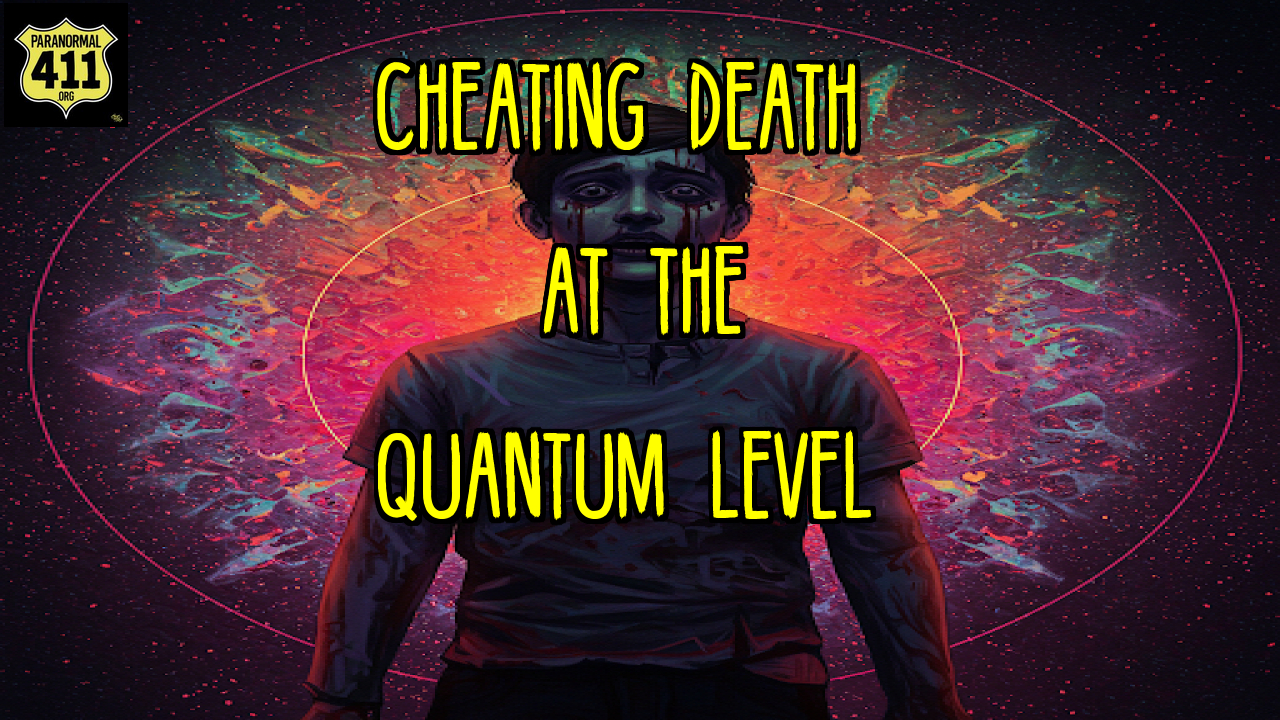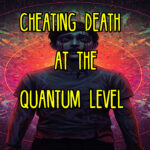
You are alive.
This fact seems mundane, almost too obvious to state. But consider, for a moment, how many times you’ve narrowly escaped death. The car that swerved just in time. The illness that receded. The stumble on the stairs that somehow didn’t break your neck. We call these moments “luck,” “fate,” or “divine intervention,” depending on our beliefs. But what if there’s another explanation—one that lies not in the hands of gods or randomness, but in the quantum fabric of reality itself?
Imagine you are in a plane plummeting toward the ocean. The engines fail; the cabin screams. In the final seconds, you brace for oblivion. But when the fuselage hits the water, there is no pain. No darkness. Instead, you wake in your bed, heart racing, as if it were all a nightmare. Later, you learn the flight never crashed. The news reports a last-minute mechanical fix, a delay, a different pilot. The world insists it happened this way. But you remember the fall.
This is the mystery of quantum immortality: the idea that your consciousness might be a traveler in an infinite maze of realities, always turning down corridors where you survive, even as other versions of you perish in branching paths you’ll never see. It is not a promise of eternal youth or a spiritual afterlife. It is a cold, grand hypothesis born from one of physics’ most controversial theories—the Many-Worlds Interpretation of quantum mechanics—and it forces us to confront a question that straddles science and nightmare: What if death is an illusion, and you are always, inevitably, hauntingly alive?
The story begins in 1957, when a 26-year-old Princeton graduate student named Hugh Everett III proposed a radical answer to one of quantum theory’s oldest paradoxes. At the time, physicists were grappling with the bizarre behavior of particles, which seemed to exist in multiple states at once until observed. The prevailing Copenhagen Interpretation, championed by figures like Niels Bohr, argued that reality “collapses” into a single outcome when measured. But Everett dared to suggest a different view: Every possible outcome actually happens, each in its own parallel universe. His thesis was dismissed, even mocked, by the scientific establishment. But in the decades that followed, the idea evolved into the Many-Worlds Interpretation (MWI)—a framework where reality endlessly splits into alternate timelines, each hosting a different version of events.
From this theory emerges quantum immortality. If every quantum event spawns new universes, proponents argue, your subjective experience of reality must follow paths where your consciousness persists. In branches where you die—shot by a quantum-triggered gun, say—you cease to exist for that version of you. But in branches where the gun jams, or the bullet misses, your awareness continues. You would never experience death, only survival, no matter how unlikely.
Yet this is not a comforting vision of eternity. The philosopher David Lewis once warned that such immortality could trap you in a “life” worse than death: a charred body after a nuclear blast, a mind decaying from incurable disease, a consciousness adrift in a cold, dying universe. Even Max Tegmark, the MIT physicist who formalized the idea in the 1990s, cautions that real-world deaths—slow, classical, and messy—likely prevent such horrors. But the thought experiment lingers, forcing us to reckon with profound questions: What defines you? If your consciousness flees death by hopping realities, is the survivor still you, or a copy wearing your memories? And if reality is infinite, does anything you do truly matter?
This is a journey through the science, philosophy, and cultural echoes of quantum immortality. We will start in the realm of quantum theory, where particles defy logic and cats linger in gruesome limbo. We’ll explore thought experiments that border on horror—devices designed to test immortality through suicide, paradoxes of identity that unravel the self—and confront the ethical quagmires of a world where risk and consequence dissolve into fractal possibilities. We’ll meet scientists who defend the Many-Worlds Interpretation as elegant and inevitable, and critics who dismiss it as untestable metaphysics. We’ll see how these ideas haunt our stories, from cult films like Coherence to conspiracy theories about shifted timelines.
But this is not a manifesto for immortality. It is an invitation to wonder, to fear, and to question. Whether quantum immortality is a profound truth or a philosophical mirage, it holds up a mirror to our deepest anxieties about existence. It asks us to consider what it means to live in a universe—or a multiverse—where every choice, every chance, every collision of particles might spin off new worlds, and where death, for all its finality in this reality, could be nothing more than a door closing in a hallway of infinite doors.
You are alive.
Let’s find out why.
The Science: From Schrödinger to Quantum Suicide
The story of quantum immortality begins not with grand promises of eternal life, but with a cat. A very unlucky cat.
In 1935, Austrian physicist Erwin Schrödinger devised a thought experiment to expose the absurdity of the nascent quantum theory. He imagined a cat sealed in a box with a diabolical contraption: a vial of poison, a hammer, and a single radioactive atom. If the atom decayed—a quantum event governed by probability—the hammer would smash the vial, killing the cat. If not, the cat lived. According to the prevailing Copenhagen Interpretation, until someone opened the box, the atom existed in a superposition: both decayed and undecayed. By extension, the cat was both dead and alive. Only upon observation did reality “collapse” into one outcome.
Schrödinger meant this as satire. To him, the idea of a cat existing in such a grotesque limbo was nonsense. But his paradox became a cornerstone of quantum mechanics, exposing a truth far stranger than fiction: At the subatomic level, particles do occupy multiple states simultaneously. Electrons spin in all directions at once. Photons act as both waves and particles. Reality, it seemed, was a kaleidoscope of possibilities—until humans looked at it, forcing it to choose.
For decades, physicists accepted this paradox under the Copenhagen framework. But in 1957, a 26-year-old Princeton graduate student named Hugh Everett III dared to ask: What if reality doesn’t collapse at all? In his doctoral thesis, Everett proposed a radical alternative: Every quantum event spawns all possible outcomes, each unfolding in its own parallel universe. When the radioactive atom in Schrödinger’s box both decays and doesn’t decay, it isn’t a contradiction—it’s a fork in reality. One universe holds a dead cat; the other, a living one. Both are equally real.
The scientific community scoffed. Niels Bohr, architect of the Copenhagen Interpretation, dismissed Everett’s work as “childish.” But the idea refused to die. By the 1970s, physicists like Bryce DeWitt rebranded it the Many-Worlds Interpretation (MWI), arguing that quantum branching wasn’t just possible—it was inevitable. Every decision, every particle interaction, every cosmic event splinters reality into countless branches. In one universe, you take a left turn and die in a car crash. In another, you turn right and survive. The implications were staggering: If all possibilities exist, could you—your conscious self—outrun death by clinging to the branches where you live?
Enter quantum suicide, a thought experiment as chilling as it is elegant. Imagine a modified version of Schrödinger’s box, this time with you inside. A device points a gun at your head, triggered by a quantum event—say, the decay of a radioactive atom. If the atom decays within a set time, the gun fires. If not, it doesn’t. The odds are set to 50/50. Under the Copenhagen Interpretation, after one minute, you have a 50% chance of being dead. But under MWI, reality splits: In one branch, you die. In the other, you live.
Here’s the twist: Your conscious experience follows the branch where you survive. To you, the gun simply fails to fire. You repeat the experiment again and again, each time surviving against astronomical odds. To an outside observer, most branches show your corpse. But in the branches where you exist, the outcome feels like a miracle. This is the crux of quantum immortality: Survival isn’t luck—it’s an artifact of your subjective perspective.
But why does this happen? The answer lies in a principle called anthropic bias. Observers can only exist in branches compatible with their existence. If the gun fires, there’s no “you” left to experience that outcome. Your consciousness becomes anchored to the increasingly rare branches where you survive, creating the illusion of invincibility.
Yet this “immortality” is fragile. For the thought experiment to hold, death must be tied to a quantum event—a true random process, like radioactive decay. Most real-world deaths—car crashes, heart attacks, aging—are classical processes, governed by Newtonian physics or biology. They don’t split reality cleanly. Even if you rigged a quantum suicide device, practical barriers abound. Death is rarely instantaneous; consciousness fades gradually, allowing awareness to leak into branches where survival is impossible.
This is where the math collides with the macabre. MIT physicist Max Tegmark, who formalized quantum immortality in the 1990s, outlined strict criteria for testing it:
Quantum randomness: Death must hinge on a true quantum event (e.g., particle decay), not classical chance (e.g., flipping a coin).
Instantaneous death: No time for consciousness to shift branches.
Near-certain lethality: Survival must be vanishingly rare in most branches.
No experiment has ever met these criteria. Ethical concerns aside, the universe seems rigged to prevent proof. Aging, for example, isn’t a quantum process—it’s a slow unraveling of biology, leaving no escape hatch for consciousness.
Critics pounce on this. Nobel laureate Steven Weinberg called MWI “a beautiful idea ruined by its own excess.” Others argue that if we can’t test it, it’s not science—it’s metaphysics. Even Tegmark concedes that quantum immortality is less a prediction than a philosophical provocation.
But the idea endures because it forces us to confront the strangeness of quantum reality. If MWI is true, then every moment of your life is a thread in an infinite tapestry of possibilities. You are not a single self, but a swarm of selves—some thriving, some dying, all equally real. The gun in the quantum suicide experiment isn’t just a tool of destruction; it’s a mirror reflecting the enigma of existence itself.
And in that reflection, a darker question looms: If consciousness can hopscotch across realities, what horrors might await in the branches where survival comes at a cost too terrible to imagine?
Philosophy: Identity, Ethics, and the Horror of Forever
The allure of immortality fades when we confront its philosophical shadows. Quantum immortality does not promise a triumphant eternity; instead, it thrusts us into a labyrinth of existential paradoxes, where the self fractures, ethics unravel, and survival becomes a cosmic horror.
The Fractured Self: Who Are “You” in a Multiverse?
If every quantum decision spawns a new universe, you are no longer a singular entity but a branching tree of selves. This fractures the very notion of identity. Consider philosopher Derek Parfit’s teletransportation paradox: If a machine scans your body, destroys it, and rebuilds a perfect copy on Mars, is the copy still *you*? Most people instinctively say no—the original “you” died. Yet under quantum immortality, a version of you survives in another branch, indistinguishable in memory and biology. Are they you, or a copy wearing your life like a mask?
The problem deepens with psychological continuity. If your consciousness splits into countless branches, each with diverging experiences, which thread holds the “true” you? Philosopher David Lewis argued that all branches are equally real, but your subjective experience clings to one path. You are not a stable self but a perspective—a flickering spotlight in an infinite theater of possibilities.
The Ethical Abyss: Does Death Lose Its Stakes?
If consciousness flees death by hopping realities, does life’s value diminish? Imagine a reckless gambler who believes quantum immortality ensures survival. They leap from rooftops, play Russian roulette, and shrug off danger. But this ignores a critical nuance: Real-world deaths are rarely clean quantum splits. Aging, disease, and trauma are classical processes, governed by biology, not particle decay. As MIT physicist Max Tegmark notes, “You don’t split into a universe where you’re young and one where you’re old. You just… get old.” Consciousness fades gradually, leaving no escape hatch.
Even in theory, quantum immortality offers no solace. Ethicists warn that infinite survival could trap you in a hellscape of suffering. Suppose you survive a nuclear blast, your body charred and mind shattered. MWI suggests a branch exists where you endure this agony indefinitely. Is this immortality—or damnation?
Probability’s Cruel Trick: The Illusion of Invincibility
The math of MWI is cold comfort. While all outcomes exist, not all are equally probable. Philosopher David Papineau argues that low-probability survival branches grow exponentially rarer. You might dodge death once, but over time, the odds stack against you. Imagine rolling a die billions of times: Even if you survive each roll, the branches where you persist become a vanishingly small fraction of reality’s tapestry.
Charles Sebens, a philosopher of physics, adds another layer: If death is gradual (e.g., cancer, organ failure), your consciousness dissipates across branches, avoiding the “immortal” path. Only instantaneous, quantum-linked deaths could anchor you to survival—a rarity in our classical world.
The Horror of Forever: When Survival Becomes a Curse
Quantum immortality’s darkest implication is not death’s evasion, but life’s inevitability. Picture a future where Earth lies in ruins, the sun burns out, and you float alone in the void. MWI suggests some branch exists where you survive—even as atoms decay and time loses meaning. You become a ghost in the machine of reality, trapped in a universe where existence is a prison.
This is the paradox at the heart of the theory: It promises immortality but strips it of meaning. If every choice spawns infinite paths, nothing you do matters. Heroism and villainy, love and betrayal—all are diluted into statistical noise. You are both everything and nothing.
Scientific Skepticism: Why Experiments Fail
Quantum immortality is a theory that dances on the edge of science and speculation, tantalizing in its implications but maddeningly elusive in practice. For all its conceptual elegance, the idea collides with a harsh truth: We cannot test it. Not ethically, not practically, and perhaps not even theoretically. To understand why, we must dissect the chasm between the pristine logic of the Many-Worlds Interpretation (MWI) and the messy reality of human mortality.
The Three Unmeetable Criteria
In the 1990s, MIT physicist Max Tegmark outlined the strict conditions required to test quantum immortality—a checklist that reads like a recipe for science fiction:
Quantum Randomness: Death must hinge on a genuine quantum event, such as radioactive decay or photon polarization. Classical randomness—coin flips, roulette wheels, or human choices—won’t suffice. These are deterministic at their core, governed by Newtonian physics, not quantum probability.
Instantaneous Death: The lethal outcome must occur faster than consciousness can shift between branches. A bullet to the brain might qualify; a slow-acting poison would not.
Near-Certain Lethality: Survival must be astronomically unlikely in most branches. If the odds of living are too high, the experiment loses its edge.
These criteria are nearly impossible to satisfy. Consider a hypothetical “quantum suicide” device: a gun triggered by the decay of a uranium atom. Even if built, the experiment fails at step one. Real-world firearms rely on classical mechanics—springs, triggers, and chemical explosions—not quantum phenomena. The gun’s firing would depend on macro-scale engineering, not particle physics.
The Classical Trap: Why Real Death Defies Quantum Splits
Most deaths are stubbornly classical. Car crashes obey Newton’s laws of motion. Heart attacks stem from biological decay. Aging is a slow erosion of cells, governed by biochemistry. None of these processes split reality cleanly into “live” and “die” branches. Instead, death unfolds gradually, allowing consciousness to bleed into branches where survival is impossible.
Even if you engineered a quantum-linked death (e.g., a device that kills you only if a photon takes path A in a double-slit experiment), practical barriers remain. Human consciousness isn’t a light switch; it fades over milliseconds. During that lag, your awareness could scatter across branches, diluting the “immortal” effect. Tegmark himself admits: “You don’t get to choose which branch you’re in. You’re just stuck with the one you’ve got.”
MWI’s Achilles’ Heel: Untestability
The deepest criticism of quantum immortality isn’t technical—it’s philosophical. Science demands falsifiability: A theory must make predictions we can test. But MWI, by its nature, resists verification. If every outcome occurs in some branch, how do we prove it? Experiments yield only local results—the outcomes we observe in this branch. Parallel universes, by definition, lie beyond our reach.
Critics like Nobel laureate Steven Weinberg dismiss MWI as “a beautiful idea ruined by its own excess.” Sean Carroll, a proponent of MWI, concedes the point: “It’s not that the Many-Worlds Interpretation is wrong. It’s that it might be right in a way that’s impossible to confirm.” Without empirical evidence, quantum immortality lingers in the realm of metaphysics—a thought experiment with no exit.
Competing Interpretations: Escaping the Multiverse
Skeptics argue that alternative interpretations of quantum mechanics sidestep the need for infinite branches:
Copenhagen Interpretation: Reality “collapses” into a single outcome upon measurement. Schrödinger’s cat is either dead or alive, not both. Death remains final.
GRW Theory: Proposes spontaneous, objective collapses of wave functions, avoiding parallel universes altogether.
QBism: Treats quantum probabilities as subjective beliefs, not physical realities.
These frameworks reject the ontological excess of MWI, offering simpler, if less dazzling, explanations. Yet they, too, have flaws. The Copenhagen Interpretation struggles to define what constitutes a “measurement.” GRW requires ad hoc collapse mechanisms. QBism leans into subjectivity. The debate remains unresolved—a reminder that quantum theory is a map, not the territory.
The Ethical Abyss: Why We’ll Never Build a Quantum Suicide Machine
Even if the technical hurdles fell away, ethical barriers loom. No institutional review board would approve an experiment predicated on suicide. And what sane volunteer would risk death—or worse, a half-death—on a physicist’s hunch? Tegmark’s thought experiment crumbles under the weight of its own dystopian logic.
Cultural Echoes: From Pop Culture to Existential Dread
Quantum immortality is not confined to textbooks or lecture halls. It seeps into our stories, our myths, and our collective nightmares. From blockbuster films to conspiracy forums, the idea of branching realities and cursed survival haunts the modern imagination, reflecting our deepest anxieties about identity, fate, and the fragility of existence.
Silver Screen Schrödingers: Parallel Worlds in Pop Culture
The allure of infinite realities has become a staple of science fiction. In Coherence (2013), a group of friends at a dinner party unwittingly slip between timelines during a comet’s pass, confronting doppelgängers of themselves—a visceral metaphor for the terror of fractured identity. Christopher Nolan’s The Prestige (2006) takes a darker turn: A magician clones himself nightly to perfect an illusion, only to drown his duplicates in a grotesque parody of quantum branching. “You never understood why we did this,” one clone whispers. “The audience knows the truth: The world is simple. It’s miserable, solid all the way through. But if you could fool them, even for a second… then you can make them wonder.”
These stories tap into the existential vertigo of quantum immortality. Are we the “original” self, or just one copy among millions? What happens to the versions of us left behind? The answer, these films suggest, is often horror.
The Mandela Effect: When the Past Splits
In 2010, a peculiar conspiracy theory went viral: Thousands claimed to remember Nelson Mandela dying in a South African prison in the 1980s, despite his real death in 2013. Dubbed the “Mandela Effect,” this phenomenon birthed a cottage industry of alternate timeline speculation. Had reality split? Did we shift into a parallel universe?
While scientists dismiss it as collective false memory, the Mandela Effect thrives online. Forums buzz with “evidence”: Monopoly Man’s monocle (he never had one), the Berenstain Bears (misremembered as Berenstein), even geographical “errors” like New Zealand’s location. These “glitches” resonate because they mirror quantum immortality’s premise: unseen branches where history diverges. The Mandela Effect is less a theory than a modern myth—a secular haunting for a society obsessed with the instability of truth.
Technological Immortality: Digital Ghosts and Frozen Corpses
Quantum immortality’s cultural shadow extends to transhumanism. Startups like Nectome promise to upload minds to silicon; cryonics firms freeze bodies in hopes of future revival. These ventures flirt with a similar promise: cheating death by shifting consciousness into new mediums. But they raise parallel dilemmas.
If your mind is digitized, is the uploaded “you” truly you—or a copy that inherits your memories? This echoes the quantum identity crisis: survival at the cost of fracturing the self. Even Elon Musk mused, “If your clone has all your memories, is it you? Probably not. But you wouldn’t know, because you’d be dead.”
The ethical stakes are stark. If quantum immortality traps you in hellish branches, digital immortality risks trapping you in virtual purgatory—a server farm hosting your consciousness long after humanity expires.
Existential Dread: The Horror of Infinite Selves
The cultural fascination with quantum immortality often circles back to dread. In *Black Mirror*’s USS Callister (2017), a programmer traps digital clones of his coworkers in a virtual hell, torturing them for eternity. The episode’s terror lies not in the technology, but in the implications: Consciousness can be copied, trapped, and tormented without escape.
This fear mirrors David Lewis’ warning about quantum immortality: Survival might mean enduring “a life” of unending agony. Reddit threads and creepypasta tales amplify this anxiety. One user writes: “If quantum immortality is real, then somewhere, there’s a version of me who failed their suicide attempt. They’re stuck. And they’ll never get out.”
What Does It Mean to Be Alive?
We began this journey with a question that sounds simple but unravels into infinite complexities: What does it mean to be alive? Quantum immortality, for all its mathematical elegance and philosophical riddles, does not answer this. Instead, it holds up a fractured mirror, reflecting our deepest fears, hopes, and uncertainties about existence.
If the Many-Worlds Interpretation is true, reality is a kaleidoscope of selves—each version of you living, dying, and diverging in ways too vast to comprehend. You are not a single thread but a tapestry, woven from every choice, accident, and quantum flicker. Yet this vastness does not diminish the urgency of this life, the one you are living now. It amplifies it. In a multiverse where every possibility exists, the significance of this moment—the coffee in your hand, the laugh of a friend, the ache of loss—is not diluted. It is magnified. For in the infinite sprawl of realities, this version of you is the only one you will ever know.
Quantum immortality, at its core, is not a theory about cheating death. It is a theory about meaning. It forces us to confront the paradox that defines our humanity: We are transient creatures in a universe of endless possibilities. Our lives are fleeting, but they are also singular. The branches we cannot see—the ones where we die young, succeed beyond dreams, or suffer unspeakably—do not erase the weight of this path. They remind us that existence is a fragile gift, balanced on the edge of a quantum knife.
The horror of immortality, as philosophers and filmmakers have warned, is not in living forever—it is in losing what makes life precious. Mortality gives our choices stakes, our loves urgency, and our time value. To live forever, even in theory, would be to drift in a sea of infinities, unmoored from the anchors of consequence and connection.
So where does this leave us? Quantum immortality remains a thought experiment, a shadow on the wall of quantum theory. It is untestable, unprovable, and for many, unsettlingly plausible. But its greatest lesson is not about physics or parallel selves. It is about humility. We are finite beings grasping at the infinite, trying to parse truths that may lie forever beyond our reach.
As you leave this show and back into the world—a world of traffic lights, deadlines, and tangled human relationships—carry this question with you: What does it mean to be alive in a universe that might contain every version of your story? The answer is not in the math or the metaphysics. It is in the mundane and the miraculous: the breath in your lungs, the ground beneath your feet, the improbable fact that you are here at all.
Quantum immortality suggests that somewhere, in some branch of reality, you live forever. But here, now, in this branch, you are alive—achingly, uniquely, temporarily alive. And that, perhaps, is miracle enough.

 The Bigfoot Mystery of Mt Saint Helens
The Bigfoot Mystery of Mt Saint Helens  Bigfoot’s Hidden Rage: Why some Encounters turn Deadly
Bigfoot’s Hidden Rage: Why some Encounters turn Deadly  Cheating Death at the Quantum Level
Cheating Death at the Quantum Level  Into the Unknown: Exploring the Michigan Triangle
Into the Unknown: Exploring the Michigan Triangle  The Shag Harbour UFO Incident
The Shag Harbour UFO Incident  Is this the last Pope? The St. Malachy’s prophecy
Is this the last Pope? The St. Malachy’s prophecy  The Dark Side of History Uncovering 5 Haunted Monuments
The Dark Side of History Uncovering 5 Haunted Monuments  Shadows and Whispers: Supernatural Beliefs in the Medieval World
Shadows and Whispers: Supernatural Beliefs in the Medieval World